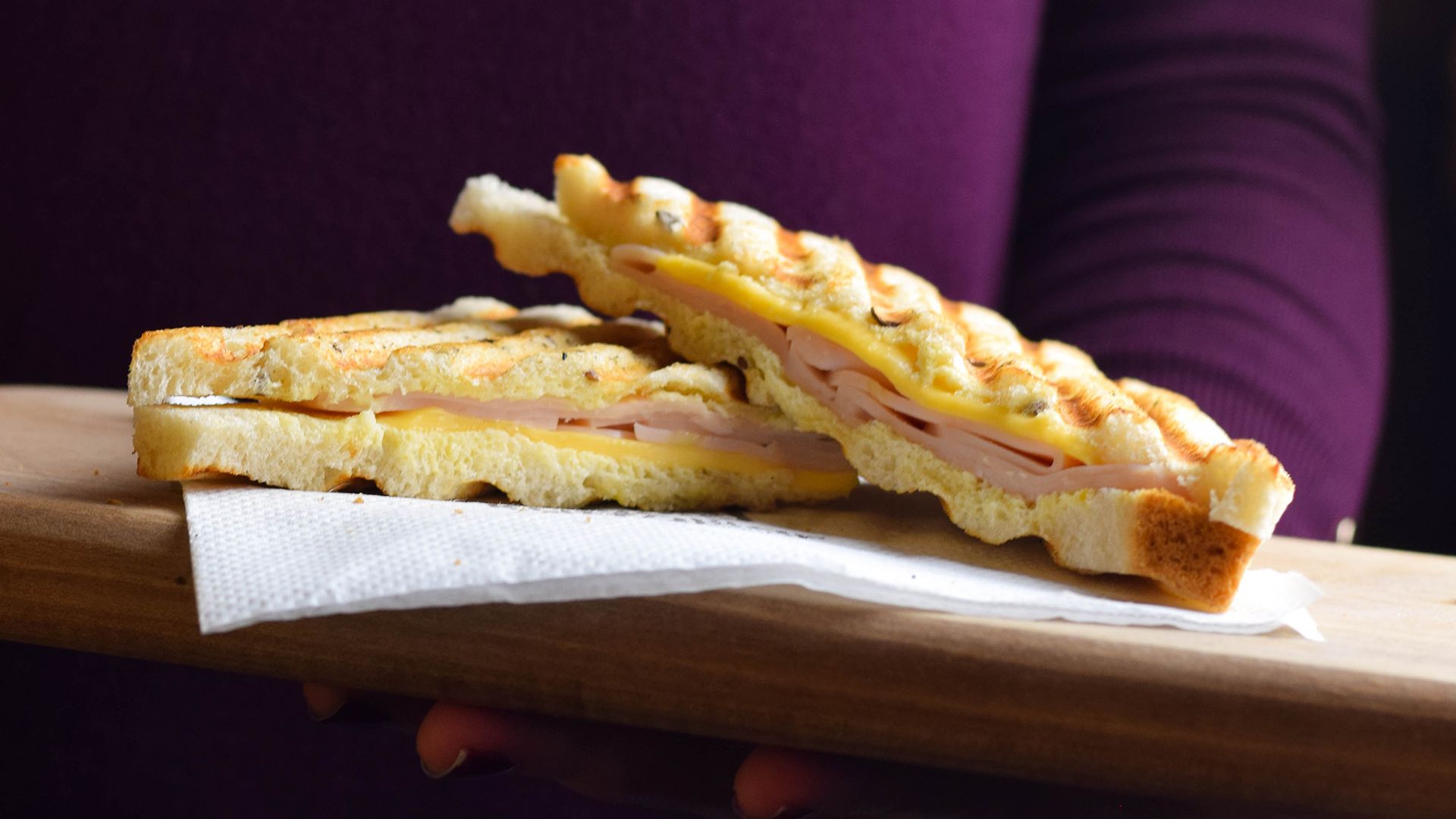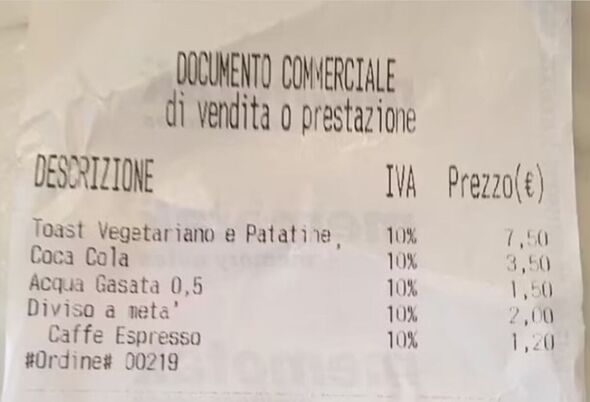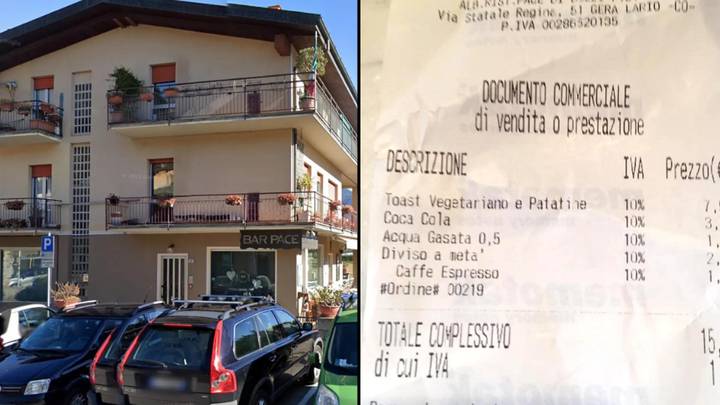Tourist Outraged Over €2 Charge To Cut Sandwich In Half
When it comes to vacation spending, the last thing travelers expect is a hefty bill for a simple culinary request. However, one tourist's recent encounter in Italy has shed light on an unexpected fee that left them incensed. The tourist outraged over €2 charge to cut sandwich in half unfolded at Bar Pace in Gera Lario, a picturesque spot along Lake Como, Italy.
Author:Scarlet SunsetReviewer:Maxwell CanvasAug 11, 202313.8K Shares347.2K Views

When it comes to vacation spending, the last thing travelers expect is a hefty bill for a simple culinary request. However, one tourist's recent encounter in Italy has shed light on an unexpected fee that left them incensed. The tourist outraged over €2 charge to cut sandwichin half unfolded at Bar Pace in Gera Lario, a picturesque spot along Lake Como, Italy.
Tourist Outraged Over €2 Charge To Cut Sandwich
The incident gained attention after the disgruntled traveler took to TripAdvisor to share their dismay,
“„We have to pay because the toast was cut in half?- Tourist
This seemingly innocuous request turned into a point of contention, revealing the intricacies of restaurant charges that often go unnoticed.
In the midst of a delightful vacation, travelers are already mindful of expenses such as flights, accommodations, and indulgent treats. However, the notion of paying extra for slicing a sandwich is a new realm of cost consideration. The tourist's experience raises questions about the transparency of charges in the hospitality industry.
The unnamed tourist recounted the situation:
“„There were two of us, and we asked for a toasted sandwich to share at the table.- Tourist
The receipt detailing the meal listed the sandwich at €7.50 ($8.27), accompanied by other items like Coca Cola (€3.50 or $3.86), water (€1.50 or $1.65), and an espresso (€1.20 or $1.32). Notably, the "diviso da meta" charge, translating to the 'cutting in half' fee, amounted to €2 ($2.20), surprisingly less than the cost of an espresso.

Cristina Biacchi, the owner of Bar Pace, responded to the incident, shedding light on the rationale behind the charge.
Biacchi emphasized:
“„Additional requests have a cost.- Cristina Biacchi, Bar Pace Owner
...explaining the need for two plates instead of one, the extended washing time, and the use of two placemats due to the modification. The complexity of the sandwich, which contained French fries, was another factor in the decision.
Biacchi also noted that the customer hadn't voiced any concerns at the time of the meal. She suggested that had the issue been brought up, the restaurant might have considered adjusting the price. However, the tourist's initial silence allowed the situation to escalate into a noteworthy discussion on social media.
In a similar vein, a recent incident emerged where a restaurant faced backlash for charging patrons for live music.
One Reddit user shared a receipt displaying an $8 charge for live music for each of their girlfriend and her friends.
“„Is this a new thing? Never come across this before.- Reddit User
This unusual fee sparked a conversation about the evolving payment methods and the subtleties of additional charges in the dining experience.
The Bar Pace incident of the tourist outraged over €2 charge to cut sandwich in half garnered such attention that TripAdvisor opted to pause new reviews for the restaurant temporarily. The website cited an influx of reviews that didn't accurately reflect firsthand experiences as the reason behind the decision.
As the world of travel and dining continues to evolve, instances like these shed light on the intricacies of pricing structures and the importance of open communication between patrons and establishments.
Whether it's an unexpected sandwich-slicing fee or a charge for live music, travelers and diners are reminded to remain vigilant about the details of their bills, ensuring that their memorable experiences aren't marred by surprising additional costs.
So what do we know about hidden restaurant charges and fees?
Hidden Charges In The Hospitality Industry
The soaring inflation rates over the past year have led to an alarming surge in prices across various sectors, significantly impacting the cost of essential items like food and fuel. With financial strain already gripping US households, consumers are now grappling with an additional financial burden: hidden costs stealthily added to their purchases before checkout or appended to their receipts post-purchase.
These concealed merchant fees, often referred to as drip pricing, are exacerbating the financial pressures faced by individuals already navigating a landscape of economic uncertainty.
This issue is not confined to the US; it's a globalconcern affecting consumers in various parts of the world. Drip pricing is becoming a growing concern as businesses seek ways to offset inflation-induced cost increases. The result is an experience where consumers find themselves paying more than anticipated for products and services, a trend that deserves closer scrutiny.
What Is The Impact Of Drip Pricing?
Drip pricing has profound implications for consumers as it blurs the lines of transparency and integrity in the consumer-business relationship. The idea that the actual price of an item or service isn't fully disclosed upfront, but rather hidden behind layers of additional fees, can lead to frustration and dissatisfaction among customers. This practice undermines the trust between businesses and consumers, leaving the latter feeling deceived and financially strained.
The impact of drip pricing is particularly felt by those already on a tight budget. Low-income Americans, in particular, are disproportionately affected by these hidden charges. The gradual accumulation of small fees can significantly impact their ability to make ends meet and manage their finances effectively.

What is drip pricing?
Is Drip Pricing A Multifaceted Issue?
Drip pricing isn't limited to one industry; it's a phenomenon that spans various sectors. Let's explore how these additional charges are surfacing across different domains:
1. Restaurants - Beyond The Food
The restaurant industry, which was hit hard during the initial waves of the COVID-19 pandemic, is now grappling with rising costs associated with food and labor. To counteract these challenges, many restaurants are adopting a range of drip pricing strategies.
Credit card surcharges, a classic example, are often subtly tacked onto the bill, taking advantage of the convenience of card payments while transferring part of the processing cost to the consumer. Similarly, surcharges labeled as "increased labor costs" or "kitchen appreciation fees" are being introduced to help cover the rising expenses of maintaining a skilled workforce.
2. Rideshare And Food Delivery Apps - Hidden Transit Costs
As rideshare companies vie for drivers in a competitive labor market, they resort to sign-on bonuses and increased pay rates. However, these incentives come at a price for riders. New fuel fees, like those introduced by Uber and Lyft, add a flat fee to each trip, ostensibly to offset the surging energy costs.
Additionally, grocery delivery apps like Instacart are tacking on fuel fees, further contributing to the rising transportation costs borne by consumers.
3. Health Care - Unforeseen Medical Expenses
The realm of health care, too, is not exempt from drip pricing practices. Apart from the well-known supply fees and facility charges, unexpected items like "health care for staff" have appeared on restaurant bills. These fees, purportedly aimed at providing better benefits for staff, further demonstrate the pervasive nature of drip pricing. Patients may not realize the financial implications until they receive an itemized bill, leaving them startled and unprepared for these additional costs.
How Can Consumers Handle Drip Pricing?
Navigating the landscape of drip pricing requires consumers to be proactive and informed. Here are a few steps consumers can take to mitigate the impact of hidden charges:
1. Question And Seek Transparency
Consumers have the right to inquire about unexpected charges before making a purchase. Businesses should provide upfront and transparent information about any additional fees associated with their products or services. Engaging in conversations about fees not only empowers consumers but also encourages businesses to adopt more transparent pricing practices.
2. Evaluate Payment Methods
Exploring various payment methods can often yield surprising results. Some establishments offer cash discounts as a way to offset credit card processing fees. Inquiring about cash discounts and comparing payment options can help consumers make more cost-effective choices.
3. Choose Wisely With Third-Party Services
While third-party delivery apps offer convenience, they can also come with substantial fees. It's worth considering ordering directly from the restaurant, which can potentially result in savings. Alternatively, tools like MealMe can aid in identifying the most cost-effective options by comparing pricing across different platforms.
4. Voice Your Dissatisfaction
Consumers have the power to shape market behavior by voting with their wallets. If faced with undisclosed fees or charges that feel unjust, expressing dissatisfaction and sharing experiences on platforms like Yelp can influence business practices. Filing complaints with credit card issuers and relevant authorities can also hold businesses accountable for violating state laws.

The 5 Cs of Pricing - How Firms Set Prices
A Global Perspective
It's important to recognize that drip pricing is not confined to the US; it's a phenomenon that's affecting consumers on a global scale. As businesses navigate economic challenges and supply chain disruptions, the introduction of hidden charges is becoming an unfortunate trend.
Consumers worldwide must remain vigilant, informed, and proactive in addressing this issue to preserve transparency and integrity in their financial transactions.
In a world where financial stability is paramount, the need for fair and transparent pricing practices cannot be overstated. By understanding the impact of drip pricing and taking control of their purchasing decisions, consumers can assert their rights and contribute to a more equitable marketplace.
As the saying goes, "Knowledge is power,"and in the realm of drip pricing, knowledge can indeed empower consumers to make informed choices and demand a pricing structure that respects their financial well-being.
People Also Ask
What Is The Most Expensive Part Of Owning A Restaurant?
Labor is the largest expense for restaurants, second only to food. Having a qualified manager is crucial in high-volume locations to manage inventory and employee scheduling efficiently.
What Are Examples Of Operating Expenses?
Operating expenses (OpEx) encompass rent, equipment, inventory costs, marketing, payroll, insurance, step costs, and funds allocated for research and development. These are the expenses a business incurs during its regular operations.
What Are Fixed Costs Examples?
Fixed costs are business expenses that remain constant regardless of business activity. Examples include rent, salaries, insurance, property taxes, interest expenses, depreciation, and, in some cases, utilities.
What Is Pricing And Costing?
Indirect or fixed costs are overhead expenses that a business must pay irrespective of whether its products are sold. This category includes items like rent, electricity, telephone bills, salaries, insurance, and depreciation. Pricing involves determining the price of your goods or services.
How Do I Calculate Food Cost?
To calculate food cost percentage, divide the cost of goods sold by the revenue generated from the finished dish. The cost of goods sold represents the money spent on ingredients and inventory within a specific timeframe.
What Are Indirect Costs In Restaurants?
Indirect costs are resources used for multiple products. In the context of a restaurant, items like a stove that serve more than one menu item are considered indirect costs. Allocating these costs to specific products can be challenging.
Conclusion
In essence, the recent incident of a tourist outraged over €2 charge to cut sandwich in half highlights a widespread problem of hidden fees and drip pricing impacting consumers worldwide. These seemingly minor charges, stemming from businesses' efforts to counter rising costs, can significantly affect consumers, particularly those with limited budgets.
Whether in restaurants, rideshare apps, or healthcare, the lack of upfront transparency erodes trust and can lead to unexpected expenses. Empowered consumers can combat this issue by questioning fees, seeking clarity, and voicing concerns. The incident's global resonance emphasizes the demand for fair pricing and transparency in financial transactions.

Scarlet Sunset
Author
Scarlet Sunset is a captivating and confident transgender individual who radiates sensuality and embraces her unique beauty. With a radiant smile and a touch of red lipstick, she captivates hearts by the poolside as the sun dips below the horizon, casting a warm glow on her unforgettable presence.
Despite societal norms and expectations, Scarlet celebrates her body, proudly defying conventional standards of beauty. Her curves tell a story of self-acceptance and empowerment, challenging stereotypes and inspiring others to embrace their own bodies without reservation.

Maxwell Canvas
Reviewer
Maxwell Canvas, a charismatic and fearless crypto evangelist, defies conventions and blazes a trail in the realm of digital currencies. With his unique physique serving as a symbol of resilience, he challenges societal norms and proves that true expertise transcends appearances. Against a backdrop of a blurred and ever-shifting market, Maxwell's work becomes a masterpiece, painting a vivid picture of knowledge and inspiration.
With unwavering passion, Maxwell empowers others to embrace the transformative potential of blockchain technology. His captivating presence and unyielding dedication captivate audiences, turning skepticism into curiosity and igniting a spark of interest in the world of cryptocurrencies. Maxwell Canvas stands as a visionary force, leaving an indelible mark on the crypto landscape, inspiring others to explore decentralized possibilities and embrace a future of innovation and financial empowerment.
Latest Articles
Popular Articles
